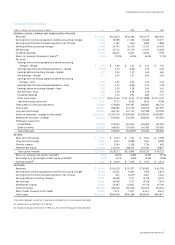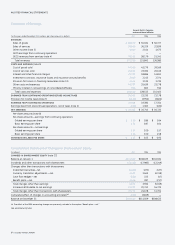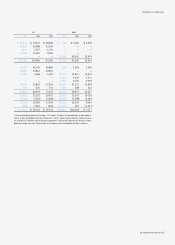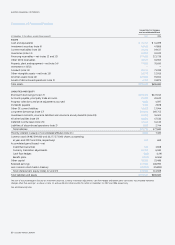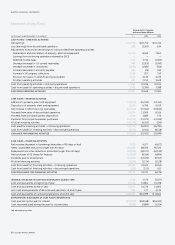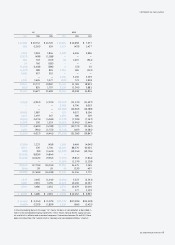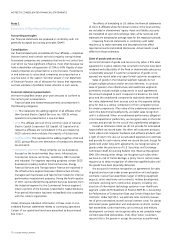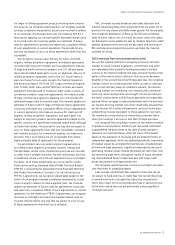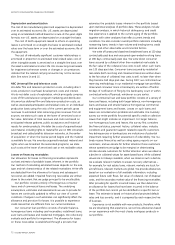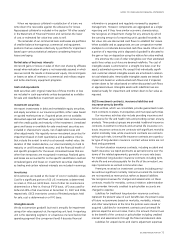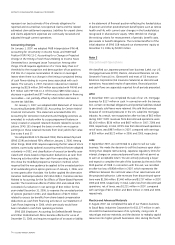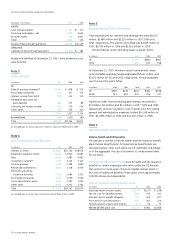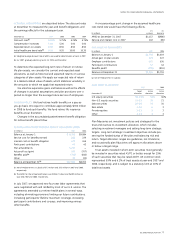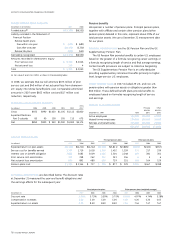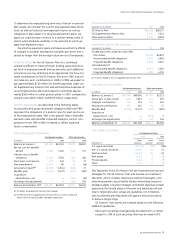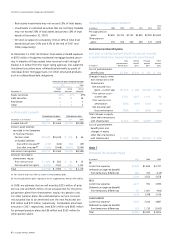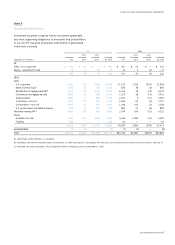GE 2007 Annual Report Download - page 75
Download and view the complete annual report
Please find page 75 of the 2007 GE annual report below. You can navigate through the pages in the report by either clicking on the pages listed below, or by using the keyword search tool below to find specific information within the annual report.
ge 2007 annual report 73
When we repossess collateral in satisfaction of a loan, we
write down the receivable against the allowance for losses.
Repossessed collateral is included in the caption “All other assets”
in the Statement of Financial Position and carried at the lower
of cost or estimated fair value less costs to sell.
The remainder of our commercial loans and leases are portfolios
of smaller balance homogenous commercial and equipment
positions that we evaluate collectively by portfolio for impairment
based upon various statistical analyses considering historical
losses and aging.
Partial sales of business interests
We record gains or losses on sales of their own shares by affi liates
except when realization of gains is not reasonably assured, in which
case we record the results in shareowners’ equity. We record gains
or losses on sales of interests in commercial and military engine
and turbo-machinery equipment programs.
Cash and equivalents
Debt securities with original maturities of three months or less
are included in cash equivalents unless designated as available-
for-sale and classifi ed as investment securities.
Investment securities
We report investments in debt and marketable equity securities,
and equity securities in our insurance portfolio, at fair value based
on quoted market prices or, if quoted prices are not available,
discounted expected cash fl ows using market rates commensurate
with the credit quality and maturity of the investment. Unrealized
gains and losses on available-for-sale investment securities are
included in shareowners’ equity, net of applicable taxes and
other adjustments. We regularly review investment securities for
impairment based on both quantitative and qualitative criteria
that include the extent to which cost exceeds market value, the
duration of that market decline, our intent and ability to hold to
maturity or until forecasted recovery, and the fi nancial health of
and specifi c prospects for the issuer. Unrealized losses that are
other than temporary are recognized in earnings. Realized gains
and losses are accounted for on the specifi c identifi cation method.
Unrealized gains and losses on investment securities classifi ed
as trading and certain retained interests are included in earnings.
Inventories
All inventories are stated at the lower of cost or realizable values.
Cost for a signifi cant portion of GE U.S. inventories is determined
on a last-in, fi rst-out (LIFO) basis. Cost of other GE inventories is
determined on a fi rst-in, fi rst-out (FIFO) basis. LIFO was used for
56% and 49% of GE inventories at December 31, 2007 and 2006,
respectively. GECS inventories consist of fi nished products held
for sale; cost is determined on a FIFO basis.
Intangible assets
We do not amortize goodwill, but test it annually for impairment
using a fair value approach at the reporting unit level. A reporting
unit is the operating segment, or a business one level below that
operating segment (the component level) if discrete fi nancial
information is prepared and regularly reviewed by segment
management. However, components are aggregated as a single
reporting unit if they have similar economic characteristics.
We recognize an impairment charge for any amount by which
the carrying amount of a reporting unit’s goodwill exceeds its
fair value. We use discounted cash fl ows to establish fair values.
When available and as appropriate, we use comparative market
multiples to corroborate discounted cash fl ow results. When all or
a portion of a reporting unit is disposed of, goodwill is allocated to
the gain or loss on disposition using the relative fair value method.
We amortize the cost of other intangibles over their estimated
useful lives unless such lives are deemed indefi nite. The cost of
intangible assets is amortized on a straight-line basis over the
asset’s estimated economic life, except that individually signifi -
cant customer-related intangible assets are amortized in relation
to total related sales. Amortizable intangible assets are tested for
impairment based on undiscounted cash fl ows and, if impaired,
written down to fair value based on either discounted cash fl ows
or appraised values. Intangible assets with indefi nite lives are
tested annually for impairment and written down to fair value as
required.
GECS investment contracts, insurance liabilities and
insurance annuity benefits
Certain entities, which we consolidate, provide guaranteed invest-
ment contracts to states, municipalities and municipal authorities.
Our insurance activities also include providing insurance and
reinsurance for life and health risks and providing certain annuity
products. Three product groups are provided: traditional insurance
contracts, investment contracts and universal life insurance con-
tracts. Insurance contracts are contracts with signifi cant mortality
and/or morbidity risks, while investment contracts are contracts
without such risks. Universal life insurance contracts are a particu-
lar type of long-duration insurance contract whose terms are not
fi xed and guaranteed.
For short-duration insurance contracts, including accident and
health insurance, we report premiums as earned income over the
terms of the related agreements, generally on a pro-rata basis.
For traditional long-duration insurance contracts including term,
whole life and annuities payable for the life of the annuitant, we
report premiums as earned income when due.
Premiums received on investment contracts (including annui-
ties without signifi cant mortality risk) and universal life contracts
are not reported as revenues but rather as deposit liabilities.
We recognize revenues for charges and assessments on these
contracts, mostly for mortality, contract initiation, administration
and surrender. Amounts credited to policyholder accounts are
charged to expense.
Liabilities for traditional long-duration insurance contracts
represent the present value of such benefi ts less the present value
of future net premiums based on mortality, morbidity, interest
and other assumptions at the time the policies were issued or
acquired. Liabilities for investment contracts and universal life
policies equal the account value, that is, the amount that accrues
to the benefi t of the contract or policyholder including credited
interest and assessments through the fi nancial statement date.
Liabilities for unpaid claims and claims adjustment expenses


